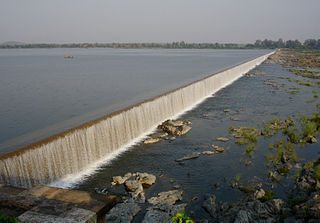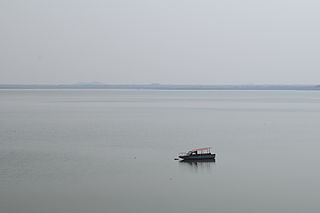Related Research Articles

The Godavari River has its catchment area in seven states of India: Maharashtra, Telangana, Chhattisgarh, Madhya Pradesh, Andhra Pradesh, Karnataka and Odisha. The number of dams constructed in Godavari basin is the highest among all the river basins in India. Nearly 350 major and medium dams and barrages had been constructed in the river basin by the year 2012.

Nizam Sagar Dam is an Indian dam named after the Nizam of Hyderabad. It is a reservoir constructed across the Manjira River, a tributary of the Godavari River, between Achampet and BanjePally villages of the Kamareddy district in Telangana, India. It is located at about 144 km (89 mi) north-west of Hyderabad. Nizam Sagar is the oldest dam in the state of Telangana.

The Sriram Sagar Project is also known as the Pochampadu Project is an Indian flood-flow project on the Godavari. The Project is located in Nizamabad district, 3 km away from National Highway 44. It has been described by The Hindu as a "lifeline for a large part of Telangana".

Nagarjuna Sagar Dam is a masonry dam across the Krishna River at Nagarjuna Sagar which straddles the border between Palnadu district in Andhra Pradesh and Nalgonda district in Telangana. The dam provides irrigation water to the districts of Palnadu, Guntur, Nalgonda, Prakasam, Khammam, Krishna, and parts of West Godavari. It is also a source of electricity generation for the national grid.
The Babli project / barrage is a controversial reservoir project being constructed by Maharashtra across the river Godavari, disputed by Telangana. The Supreme Court of India delivered a ruling after seven years in favour of Maharashtra with the Andhra Pradesh government expected to appeal against it.
The J. Chokka Rao Devadula lift irrigation scheme is a lift irrigation scheme in India. It is the second biggest of its kind in Asia. Devadula is the place in Mulugu District, Telangana, where the scheme's intake well is located. The foundation stone for this scheme was laid by the Chief Minister of Combined State Shri. Nara Chandra Babu Naidu in the year 2001.

The Polavaram Project is an under construction multi-purpose irrigation project on the Godavari River in the Eluru District and East Godavari District in Andhra Pradesh. The project has been accorded National project status by the Central Government of India. Its reservoir back water spreads up to the Dummugudem Anicut and approx 115 km on Sabari River side. Thus back water spreads into parts of Chhattisgarh and Odisha States. It gives major boost to tourism sector in Godavari Districts as the reservoir covers the famous Papikonda National Park, Polavaram hydro electric project (HEP) and National Waterway 4 are under construction on left side of the river. It is located 40 km to the upstream of Sir Arthur Cotton Barrage in Rajamahendravaram City and 25 km from Rajahmundry Airport.
The Pulichintala Project is a multi-purpose water management project for irrigation, hydropower generation, and flood control in the state of Andhra Pradesh, India. It is a crucial irrigation facility for farmers in four coastal districts: West Godavari, Krishna, Guntur, Palanadu, and Prakasam, covering over 13 lakh acres. It has 24 gates and a balancing reservoir with a capacity of 46 Tmcft at 175 feet (53 m) MSL full reservoir level (FRL).

Sripada Yellampalli Project is an Irrigation project located at Yellampalli Village of Ramagundam rural Mandal, between Peddapalli district - Mancherial District of Telangana State, India. The project is fourth largest on the Godavari River in Telangana State. It is named after late legislator, D. Sripada Rao.

Rajiv Dummugudem Lift Irrigation Scheme is a lift irrigation scheme under execution which are located near Dummugudem, Khammam district in Telangana, India. There are three lift irrigation schemes by names Rajiv Dummugudem lift irrigation scheme, Indirasagar Rudrammakota Dummugudem lift irrigation scheme and Dummugudem to Sagar tail pond canal project. Rajiv Dummugudem lift irrigation scheme starting at 17°54′05″N80°52′45″E is planned to supply irrigation water for 200,000 acres in Khammam and Warangal districts drawing Godavari River water from the Dummugudem pond. Indira Dummugudem lift irrigation scheme starting at 17°33′49″N81°14′49″E is planned to supply irrigation water for 200,000 acres in Khammam, Krishna and West Godavari districts drawing Godavari River water from the back waters of Polavaram reservoir.
Icchampally Project was a multi-purpose project proposed in 2008, with hydro electricity generation, irrigation, flood control, etc. benefits on the River Godavari in India. This project is proposed as joint project of Telangana, Maharashtra and Chhattisgarh states.

The Tungabhadra Dam, also known as Pampa Sagar, is a water reservoir constructed across the Tungabhadra River in the city of Hosapete in Vijayanagara district, Karnataka, India. It is a multipurpose dam serving irrigation, electricity generation, flood control, etc. for the state. It is one of the only two non-cement dams in India, the other being the Mullaperiyar Dam in Kerala. The dam is built of surki mortar, a combination of mud and limestone, commonly used at the time of its construction.

Nagarjuna Sagar tail pond is a multipurpose reservoir located 21 km downstream from the Nagarjuna Sagar Dam across the Krishna River near Satrasala in Nalgonda district, India. Its gross water storage capacity is 6 Tmcft. The reservoir water spread area extends up to the toe of the Nagarjuna Sagar dam. The project was completed by July 2014.

Lower Manair Dam also known as LMD was constructed across the Manair River, at Alugunur village, Thimmapur mandal, Karimnagar District, in the Indian state of Telangana during 1974 to 1985. It provides irrigation to a gross command area of 163,000 hectares.
The Kadem Project is a reservoir on the river Kadem, a tributary river of Godavari near Kademm Mandal, Nirmal District, Telangana. This project covers localised ayacut under Nirmal and Mancherial Districts.

The Sri Komaram Bheem Project is a Medium Reservoir has been built across Peddavagu River, a tributary of the Pranahita River. It is located at Ada village, Asifabad Mandal, Komaram Bheem district, Telangana.
SRSP Flood Flow Canal also known as Sriram Sagar Flood Flow Canal, is a 130 km long gravity canal from Sriram Sagar Project, Village & Mandal Mupkal, Nizamabad District to Mid Manair Dam, Manwada Village, Karimnagar District, Telangana.
Pattiseema Lift Irrigation Project is a river interlinking project which connects Godavari River to Krishna River. This project has thereby become the first of such irrigation type projects in the country to be completed in time without any budget enhancements. It also holds a record in Limca Book of Records. The project was Inaugurated by the Chief Minister of Andhra Pradesh Nara Chandrababu Naidu in March 2016 while the project was completed in one year record of time.
The Kaleshwaram Lift Irrigation Project (KLIP) is a multi-purpose irrigation project on the Godavari River in Kaleshwaram, Bhupalpally, Telangana, India. Currently the world's largest multi-stage lift irrigation project, its farthest upstream influence is at the confluence of the Pranahita and Godavari rivers. The Pranahita River is itself a confluence of various smaller tributaries including the Wardha, Painganga, and Wainganga rivers which combine to form the seventh-largest drainage basin on the subcontinent, with an estimated annual discharge of more than 6,427,900 acre-feet (7,930 cubic hectometres) or 280 TMC. It remains untapped as its course is principally through dense forests and other ecologically sensitive zones such as wildlife sanctuaries.
Tummidihetti Barrage is a proposed barrage across Pranhita River, a tributary of Godavari River at Tummidihetti village, Koutala mandal, Adilabad district of Telangana State. The project will provide irrigation facilities for an ayacut of 2,00,000 acres in drought prone areas in East Adilabad District of Telangana State..
References
- ↑ "Pranahita-Chevella project foundation in April 2007". The Hindu . 16 October 2006. Archived from the original on 29 October 2006. Retrieved 15 September 2014.
- ↑ "Pranahita-Chevella works soon". The Hindu . 21 November 2008. Archived from the original on 10 November 2012. Retrieved 15 September 2014.
- ↑ "Sripad Sagar (Yellampalli) Major Irrigation Project JI00042". Archived from the original on 14 August 2016. Retrieved 15 September 2015.
- ↑ "Sripada Sagar Barrage B00455" . Retrieved 15 September 2015.
- ↑ "Kaleshwaram project line diagram" . Retrieved 15 August 2017.
- ↑ "GWDT Award, Annexure B dated 7 August 1978" (PDF). Government of India. Retrieved 21 March 2016.
- ↑ "List of head works (dam, barrage, weir, anicut, lift)in Maharashtra state". Government of India. Retrieved 21 March 2016.
- ↑ "Pranahita-Chevella agreement to open new chapter in water sharing". The Hindu. Retrieved 15 September 2014.
- ↑ "TS-Maha Talks on Oct 20 to Decide Tummadi Hatti Height". Archived from the original on 30 October 2015. Retrieved 14 October 2015.
- ↑ "Supreme Court verdict on Babhali project dispute". February 2013. Retrieved 21 March 2013.
- ↑ "Pranahita Chevella lift irrigation project progress proposal" . Retrieved 15 May 2013.
- ↑ "Bhopalpattanam project" (PDF). Retrieved 15 May 2016.



